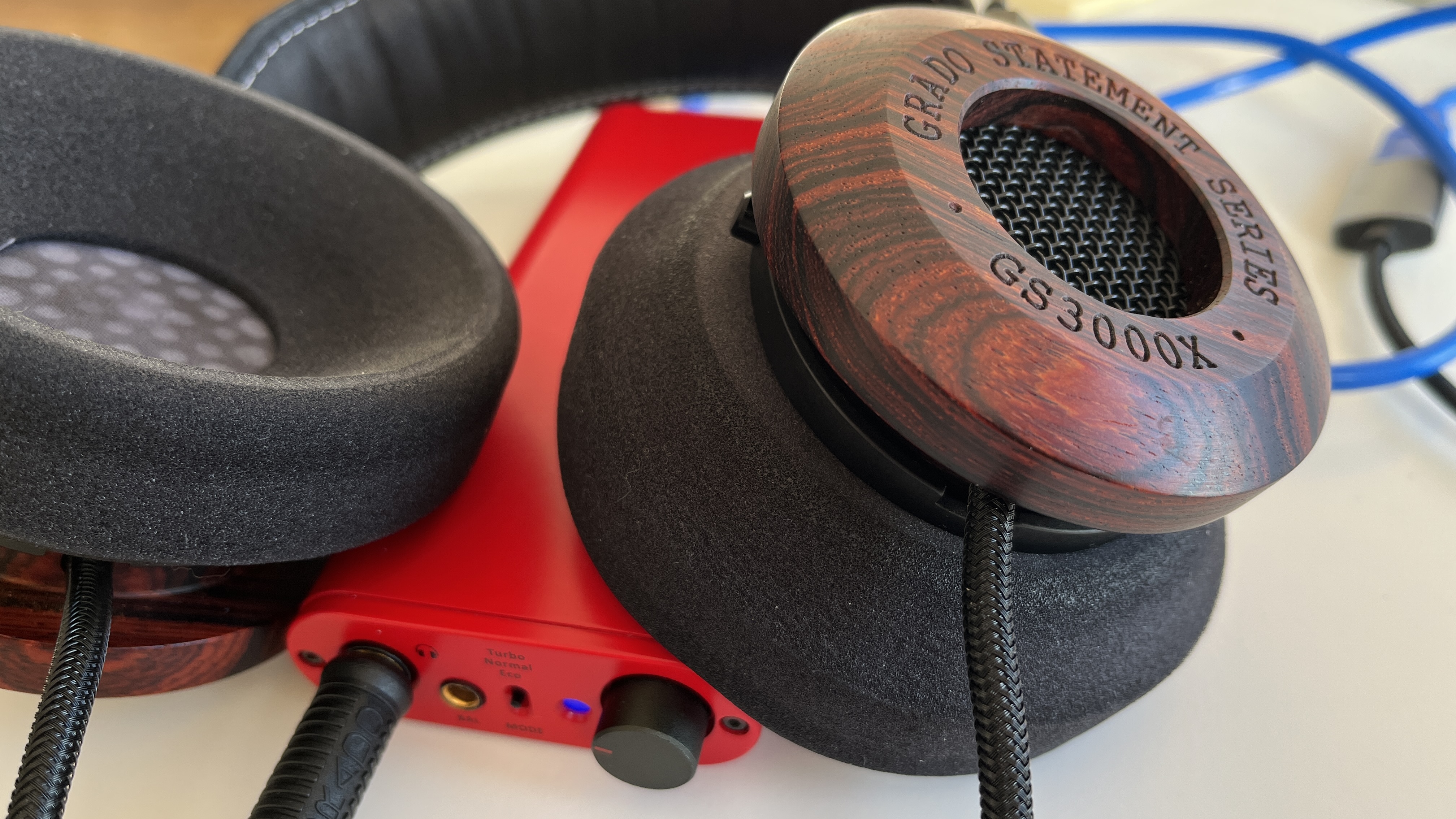Grado GS3000x Statement review: mind-blowing sound with an eye-watering price tag
The Grado GS3000x Statement wired headphones don't come cheap but the sound quality is undoubtedly out to impress



They’re not cheap, they could easily be considered a bit daft-looking, and they leak sound in the most anti-social manner. And yet these Grado GS3000x Statement are among the most straightforwardly satisfying ways to listen to music around.
-
+
Exquisitely detailed, naturalistic sound quality
-
+
Will make the best of any source of music
-
+
Uncompromising looks
-
-
Uncompromising looks
-
-
About the leakiest open-backed headphones we’ve ever heard
-
-
Cable is uncooperative
Why you can trust T3

You can forget concepts of ‘modernity’. If it’s a pair of expensive over-ear headphones you’re after, your Grado option is going to be a throwback - visually, at least.
The new GS3000x Statement are a case in point: they’ve had so much attention paid to the way they perform when you’re wearing them, their appearance seemingly hasn’t had a look-in.
So what exactly can you expect when you put a lot of money Grado’s way? And can it possibly be worth the way you look when you’re wearing them?
Grado GS3000x Statement review: price and release date
The Grado GS3000x Statement wired over-ear headphones are on sale now, and in the UK they cost a not-inconsiderable £2195. In the company’s native America, meanwhile, they’re barely more palatable $1995, while Australian customers are likely to have to part with AU$3495. These prices assume you don’t fancy the balanced XLR connectors - if you do, you’re looking at £2395/$2165/AU$4195 or thereabouts.
This is big money for a pair of headphones, no two ways about it. But it’s not as if Grado is the only company that wants to part you from plenty of cash for some over-ear headphones - Final Audio, Focal and Sennheiser (to name but three) are all ready to sell you alternatives costing this much or more.
Grado GS3000x Statement review: what's new

These GS3000x Statement open-backed over-ear headphones replace the long-running and extremely well-regarded GS3000e. Anyone expecting a radical departure from the outgoing model, though, a) doesn’t know much about the Grado methodology, and b) needs to think again.
While there have been componentry changes, the external fundamentals of the GS3000x remain the same as those of the GS3000e. That means a sonically-desirable-but-hellishly-leaky open-backed configuration, earpads so large they make the wearer look risible no matter how big their head, a headband that seems to have been padded under duress, and a hard-wired configuration that features a cable as thick as your thumb.
The changes are well worth discussing, mind you. That cable, for instance, is a new super-annealed copper 12-conductor affair in a more durable (and less flexible) sheath. The GS3000x marks the first appearance of Grado’s new 52mm ‘X Driver’ - it’s good, so the company says, for frequency response of 4Hz - 51kHz. It features a new, more powerful magnetic circuit, and voice-coil that’s gone the other way in terms of effective mass, and an entirely reconfigured diaphragm.
The driver sits in a hybrid metal chamber that is itself integrated into Cocobolo tropical wood housings. Grado is convinced the wood’s sonic properties and mass make it the ideal material to form the earcups - the fact that it looks decorative and dramatic at the same time is almost certainly coincidental.
Grado GS3000x Statement review: design and fit

Heaven knows not much of particular note has happened in the world of headphones design for decades now - but the way Grado goes about designing its over-ear headphones, you’d think ‘design’ had been outlawed before the first Beatles album was released.
That the GS3000x Statement are rigorously engineered, painstakingly constructed and specified without compromise is not up for question. But ‘design’? That’s just something that happens to other companies. And the more expensive a specific pair of Grado headphones, the more apparent their, ahem, agricultural appearance becomes. The very lightly padded leather headband now features a white-stitching accent - this is what passes for ‘design’ in Grado-land.
Where usability is concerned, well, this is a pair of headphones - you’d have to go some to deliver a pair of over-ear headphones that wasn’t fit for purpose. Here too, though, Grado’s idiosyncratic approach to design makes the GS3000x Statement a singular proposition.
The headband adjustment mechanism, though perfectly effective, is barely worthy of the description - a captive metal rod simply slides up and down inside a big plastic housing. Though the headband itself feels quite meanly padded, the GS3000x don’t feel their 515g weight thanks to a properly considered hanger arrangement. Though the foam ‘G-cushion’ earpads are big and bulky, they stay cool and comfortable even during long listening sessions. And even though that 198cm cable is chunky, it’s… actually, no, There’s no soft-pedalling the 12-core cable. It’s heavy, seems impossible to straighten and is very keen indeed to tangle in on itself.
Grado GS3000x Statement review: performance

Unlike some expensive headphones we could mention, the Grado GS3000x don’t sneer at ordinary sources of music - instead, they try to make the best of them. But the fact of the matter is: if you’re spending £2K and more on some headphones, the equipment you plug them into needs to be similarly talented (and, inevitably, comparably expensive) if you’re really going to hear where all that money went.
So for the purposes of this test, the GS3000x Statement are plugged into £1000-worth of iFi iDSD Diablo desktop DAC/headphone amp - it’s a deeply capable device, and one that is capable of bringing the best from the Grado. It doesn’t take all that long a listen to confirm it.
More than anything, the GS3000x are a profoundly musical listen. That may seem like a redundant description when discussing a product designed to deliver music, but there are enough unmusical headphones around (at all sorts of prices) that ‘musicality’ is a trait to be admired. And these Grado are just about as musical as headphones get.
They’re a natural, neutral-sounding pair of headphones, more than happy to get out of the way of a recording and let it express itself. The amount of detail they retain and relate is staggering - from the tiniest transient occurrences at the very edge of the soundstage to the minutiae of a singer’s breath-management and mic technique, the GS3000x communicate in a manner best described as ‘torrential’. If it’s present in a recording, no matter how minor or how deeply buried in a mix, the Grado will identify it, contextualise it and serve it up for your inspection.
Tonality is entirely convincing, from the deep and textured low frequencies to the bright, shining top end. The Grado control low-frequency information is something approaching fanaticism, describing utterly straight edges at the attack of individual sounds and managing their decay in equally confident fashion. This sort of inherently correct low-frequency response allows rhythms and tempos the most eloquent expression.
In the midrange, the midrange is among the most articulate and expressive we’ve heard. Whatever a singer’s level of competence and of commitment, their character and attitude and emotional state, the Grado make it unequivocal. They’ll let a torch singer break your heart, they’ll allow a rabble-rouser to get your blood up, they’ll let a balladeer soothe you. We’ll say it again: if it’s present in a recording, the GS3000x Statement will locate it.
Integration of the entire frequency range is smooth in the manner of cashmere. Dynamic headroom is considerable, the Grado remaining heroically unstressed even when the entire symphony orchestra attempts to take the roof off. And where those ephemeral dynamic variations present in an unaccompanied voice or solo instrument are concerned, the Grado does everything but shine a spotlight on them.
Downsides are very few, and none of them have anything to do with the way the GS3000x sound when you’re wearing them. There’s the (only sensible) need for decent source equipment and, ideally, nice high-resolution content to listen to. And there’s the way the Grado more-or-less insist you’re alone when you do your listening - the GS3000x Statement are among the leakiest headphones we’ve ever encountered, and are sure to enrage anyone within earshot (unless they enjoy the sound of some wasps fighting in a jar). Other than that, we don’t have a bad word to say about the way they perform.
Grado GS3000x Statement review: verdict

If you want to get to the heart of a recording, if you value precision but dislike analysis, if you never want to worry that you’re not getting the complete sonic picture, then the Grado GS3000x Statement could be the very headphones for you. If you can afford them, and if you don’t mind looking a bit odd when you’re listening, at least.
Grado GS3000x Statement review: also consider
The Focal Stellia are our favourite uber-expensive wired over-ear headphones, that’s why they feature in the T3 guide to the best wired headphones. That they’re better-looking - that’s to say, less rustic in appearance - than the Grado GS3000x Statement doesn’t really seem up for question. But as far as sound quality is concerned, well… it’s probably safest to say the Focal and Grado sound quite distinct from each other, rather than one is objectively better than the other. If you’re fortunate enough to have this sort of money to drop on some new headphones, you’ll need to hear both of these.
Sign up to the T3 newsletter for smarter living straight to your inbox
Get all the latest news, reviews, deals and buying guides on gorgeous tech, home and active products from the T3 experts
Simon Lucas is a freelance technology journalist and consultant, with particular emphasis on the audio/video aspects of home entertainment. Before embracing the carefree life of the freelancer, he was editor of What Hi-Fi? magazine and website – since then, he's written for titles such as Wired, Metro, the Guardian and Stuff, among many others. Should he find himself with a spare moment, Simon likes nothing more than publishing and then quickly deleting tweets about the state of the nation (in general), the state of Aston Villa (in particular) and the state of his partner's cat.
-
 Eufy’s latest robot vacuum doubles as a portable deep cleaner for spot cleaning
Eufy’s latest robot vacuum doubles as a portable deep cleaner for spot cleaningA global first in home cleaning tech
By Lizzie Wilmot Published
-
 iPad reportedly getting major makeover and your current model could benefit too
iPad reportedly getting major makeover and your current model could benefit tooApple is said to be making a change that iPad power users have been wanting for years
By Carrie Marshall Published
-
 Eve’s smart plug gets impressive Matter upgrades – but I’m most excited about the app
Eve’s smart plug gets impressive Matter upgrades – but I’m most excited about the appEve Energy adds Matter support and an updated Android app
By Bethan Girdler-Maslen Published